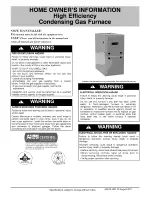
30
440 01 1051 02
Specifications are subject to change without notice.
2. Check hole sizes by making sure it is smaller than the
couplings or elbows that will be installed on the outside. The
couplings or elbows
MUST
prevent the pipe from being
pushed back through the wall.
3. Extend vent pipe and combustion air pipe through the wall
3
/
4
″
(19.1mm) to 1
″
(25.4mm) and seal area between pipe
and wall.
4. Install the couplings, nipple and termination elbows as
shown and maintain spacing between vent and combustion
air piping as indicated in
Figure 22
and
Figure 23
.
A metal shield is recommended 18
″
x 18
″
(457.2mm x 457.2mm)
min. or 18
″
(457.2mm) min. diameter around the vent termination
at the exterior wall to protect the house exterior materials from flue
product or condensation (freezing) damage.
Using Exterior Risers
1. Install
elbows and pipe to form riser as shown in
Figure 23
.
2. Secure
vent
pipe to wall with galvanized strap or other rust
resistant material to restrain pipe from moving.
3. Insulate
pipe with Armaflex or equivalent moisture resistant
closed cell foam insulation or fiberglass insulation if boxed
in and sealed against moisture.
Figure 23
Sidewall Termination with Exterior
Risers to Get Above Snow Level or
Grade Level
EXHAUST
INLET
25-00-04F
GRADE LEVEL
SNOW LEVEL
OR
8” (203.2mm)* MIN.
20’ (6.1m) MAX
*18
(457.2mm) Minimum for
cold climates [sustained 0
_
F
(-17
_
C) and below for 24 or
more consecutive hours]
8” (203.2mm)
MIN.
12 ” (304.8mm)
MIN.
Vertical Termination
1.
Figure 25
shows the proper installation and clearances for
vertical vent termination. The vertical roof termination
should be sealed with a plumbing roof boot or equivalent
flashing. The inlet of the intake pipe and end of the exhaust
vent must be terminated no less than 12
″
(307.8mm) above
the roof or snow accumulation level, and 12
″
(307.8mm)
away from a vertical wall or other protrusion.
2. If the vent system is installed in an existing chimney make
sure clearances shown in
Figure 25
are maintained.
Horizontal section before the termination elbow can be
extended on the inlet air to provide necessary clearance.
Figure 24
Recommended Alternate Installation
for Sustained Cold Weather [0
F(-17
C) & below for 24
hours or more consecutive hours]
OVERHANG
12
(304.8mm) MIN
.
12
(304.8mm) MIN. Ground
Level OR Snow Level
INLET
EXHAUST
90
Same Joist
Space
FRONT VIEW
SIDE VIEW
12
(304.8mm)
25-23-73
Figure 25
Rooftop Termination
A
A
B
A = 12
″
(304.8mm) Above roof or snow accumulation level
B = 8
″
(203.2mm) Min., 20
′
(6.1m) Maximum, except in areas
with extreme cold temperatures [sustained 0
°
F(
−
17
°
C) and be-
low for 24 or more consecutive hours], the 18
″
(457.2mm) Min.
Vent Termination Shielding
Under certain wind conditions some building materials may be
affected by flue products expelled in close proximity to
unprotected surfaces. Sealing or shielding of the exposed
surfaces with a corrosion resistant material (such as aluminum
sheeting) may be required to prevent staining or deterioration. The
protective material should be attached and sealed (if necessary) to
the building before attaching the vent terminal.
















































